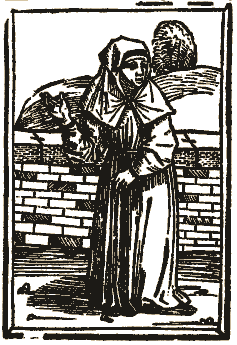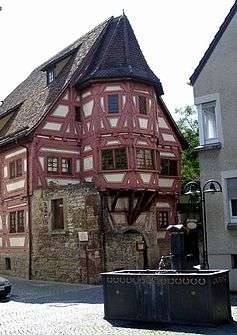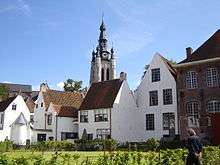Beguines and Beghards

The Beguines /bəˈɡiːnz/ and the Beghards /bəˈɡɑːrdz/ were Christian lay religious orders that were active in Northern Europe, particularly in the Low Countries in the 13th–16th centuries. Their members lived in semi-monastic communities but did not take formal religious vows. That is, although they promised not to marry "as long as they lived as Beguines" to quote one of the early Rules, they were free to leave at any time. Beguines were part of a larger spiritual revival movement of the thirteenth century that stressed imitation of Christ's life through voluntary poverty, care of the poor and sick, and religious devotion.
Etymology
The term "beguine" (Latin, "beguinas'', Dutch, "begijn") is of uncertain origin and may have been pejorative.[1] Scholars no longer credit the theory expounded in the 1911 Encyclopædia Britannica that the name derived from Lambert le Bègue, a priest of Liège. Other theories, such as derivation from the name of St. Begga and from an imaginary old Saxon word beggen, "to beg" or "to pray", have also been discredited.[2] The origin of the movement's name will continue to be as uncertain as dates for the beginning of the movement itself.[3][4] There is likewise no evidence that Beguines ever formed part of the Albigensian heretical groups. Encyclopedias, when they mention this latter explanation at all, tend to dismiss it.[5]
Beguines

At the start of the 12th century, some women in the Low Countries lived alone and devoted themselves to prayer and good works without taking vows. At first there were only a few of them, but in the course of the century, their numbers increased. Due to the structure of urban demographics and marriage patterns in the Low Countries, in the Middle Ages there were more women than men.[6] These women lived in towns, where they attended to the poor. During the 13th century, some of them bought homes that neighbored each other, and finally formal living spaces for many women formed a community called a béguinage. Beguinages tended to be located near town centers and were often close to the rivers that provided water for their work in the cloth industry in the Low Countries.
Beguines were not nuns; they did not take vows, could return to the world and wed if they chose and did not renounce their property. If one was without means, she neither asked nor accepted alms but supported herself by manual labour or by teaching the children of burghers. During the time of her novitiate, she lived with "the Grand Mistress" of her cloister, but afterward she had her own dwelling. If she could afford it, she was attended by her own servants. She was bound to her companions by having the same goals in life, kindred pursuits and a community of worship. It has been disputed that Marie of Oignies is perhaps the earliest beguine. Prior to her active spiritual expressiveness, women – particularly the laity – held little voice in the church. This early feminist voice was recorded by Jacques de Vitry and Thomas of Cantimpre.[7]
Beguinages were not convents. There was no overarching structure such as a mother-house. Each beguinage adopted its own rule. The Bishop of Liège created a rule for beguines in his diocese.[8] However, every community was complete in itself and fixed its own order of living. Later many adopted the rule of the Third Order of Saint Francis. These communities were varied in terms of the social status of their members; some of them only admitted ladies of high degree; others were exclusively reserved for persons in humble circumstances; others again opened their doors wide to women of every condition and these were the most densely peopled. Several, like the great béguinage of Ghent, numbered their inhabitants by thousands. Douceline of Digne (c. 1215-74) founded the Beguine movement in Marseille; her hagiography, which was composed by a member of her community, sheds light on the movement in general.[9]
This semi-monastic institution was adapted to its age and spread rapidly throughout the land. Some beguines became known as "holy women" (mulieres sanctae), and their devotions influenced religious life within the region. Beguine religious life was part of the mysticism of that age. There was a béguinage at Mechelin as early as 1207, at Brussels in 1245, at Leuven before 1232, at Antwerp in 1234 and at Bruges in 1244. By the close of the century, most communes in the Low Countries had a béguinage; several of the great cities had two or more.
As the 13th century progressed, the women tended to become mystics and relied less on their own labour, often turning to begging instead. In some cases, this shift toward mysticism caused problems for them. Marguerite Porete, a French Beguine and mystic, was burned at the stake in Paris in 1310 by civil authorities (heresy was against state law at that time). She was condemned by the Catholic Church for heresy and accused of being a Free Spirit. She was finally condemned and executed for reasons that are still not entirely clear. One reason may have been her refusal to remove her book The Mirror of Simple Souls from circulation.
By the 14th century, some communities were absorbed by monastic and mendicant orders. Others developed into flagellants or other practices considered heretical. In 1311, Pope Clement V accused the Beguines of spreading heresy. They were suppressed under John XXII, Urban V and Gregory XI. They were rehabilitated in the 15th century by Eugene IV.
Most of these institutions were suppressed during the Protestant Reformation of the 16th century or during the stormy years of revolutions and social unrest of the French Revolution. A few béguinages persisted until the early 20th century in parts of Belgium, including those of Bruges, Lier, Mechelin, Leuven and Ghent, which last numbered nearly a thousand members in 1905.

Marcella Pattyn, the last traditional Beguine, died on 14 April 2013 in Kortrijk at the age of 92. Born in the Belgian Congo in 1920, she was accepted into the Béguinage of St Elisabeth at Sint-Amandsberg, Ghent in 1941 and moved to the Béguinage of St Elisabeth at Kortrijk in 1960, where she became one of a community of nine.[10][11][12]
The community of the Amsterdam Begijnhof, credited with having considerably influenced the development of what was the city's southern edge in the late Middle Ages, survived the Protestant Reformation staunchly Catholic. Their parish church was confiscated and given over to exiled English Puritans. The last Amsterdam Beguine died in 1971,[13] but the Begijnhof remains one of the city's best-known landmarks.
Second wave
Writer Jean Hughes Raber, a student of medieval women's movements, posited a second wave of the Beguine movement, which occurred in the 17th century, when it was supported by Archbishop Mathias Hovius. His involvement included helping improve the Great Beguines at Mechelen. Raber says there was no clear end to the Second Movement. He suggests that Catholic lay movements, such as those of Dorothy Day in the United States, the Company of St. Ursula and communities of women initiated by Francisca Hernandez can be seen as extensions of the Beguines into the 20th century.
Third wave
Raber suggests the Beguines' response to social and economic forces in the 12th century offer a model that can meet current conditions: economic uncertainty or worse, single women comprising a larger section of the population, loss of wealth in the form of deflated values of housing. She notes a California-based group, the American Beguines, as an example of revival of the Beguine Movement, with notable but not necessarily problematic differences.[14] In the last decades, a new Beguine movement arose in Germany.[15] Recently, the Beguines of Mercy were founded in Vancouver, Canada. It is a contemplative, secular order of educated Catholic women, whose roots are in spiritual community. Their affiliations are good works, quiet contemplation and living out their spiritual values.[16]
Beghards
A widespread religious revival inspired several societies for men which were kindred to the Beguines. Of these, the Beghards were the most numerous and the most important.
The Beghards were all laymen and, like the Beguines, they were not bound by vows, the rule of life which they observed was not uniform, and the members of each community were subject only to their own local superiors. They held no private property; the brethren of each cloister had a common purse, dwelt together under one roof and ate at the same board. They were for the most part men of humble origin—weavers, dyers, fullers and so forth—they were closely connected with the city craft-guilds. For example, no man could be admitted to the Beghards' community at Brussels unless he were a member of the Weavers' Company. The Beghards were often men to whom fortune had not been kind—men who had outlived their friends, or whose family ties had been broken by some untoward event and who, by reason of failing health or advancing years, or perhaps on account of some accident, were unable to stand alone. If "the medieval towns of the Netherlands found in the beguinage a solution of their feminine question", the growth of the Beghard communities provided a place for the worn-out working man.
The men had banded together in the first place to build up the inner man. While working out their own salvation, they remained mindful of their neighbors and, thanks to their connection with the craft-guilds, they influenced the religious life. They are credited with shaping the religious opinion of the cities and towns of the Netherlands for more than 200 years, especially for the peasant.
Relation to the Church
According to John of Ruysbroeck, their religious and political opinions were similar to those expressed by anarchists of later centuries. Religious authorities believed their members had heretical tendencies and sometimes tried to bring disciplinary measures against them. The Synods of Fritzlar (1259), Mainz (1261) and Eichstätt (1282) brought measures against them and they were forbidden as "having no approbation" by the Synod of Béziers (1299). They were condemned by the Council of Vienne (1312), but this sentence was mitigated by Pope John XXII (1321), who permitted the Beguines to resume their mode of life after reform.
The Beghards were more obstinate; during the 14th century, they were repeatedly condemned by the Holy See, the bishops (notably in Germany) and the Inquisition. The Catholic Encyclopedia acknowledges that men of faith and piety were found among the Beghards. In their behalf, Pope Gregory XI (1374–77) and Pope Boniface IX (1394) addressed Bulls to the bishops of Germany and the Netherlands. The doctrine of Quietism is believed to resemble the stance of these community members.
Decline
Before the close of the Middle Ages, Beghard communities were in decline. Their numbers diminished with the waning of the textile trade and, when that industry died, gradually dwindled away. The highest number of such medieval foundations in Flanders and Wallonia was 94, but in 1734 they had been reduced to just 34 and in 1856 to 20.
Literary references
- In his multi-volume novel The Life and Opinions of Tristram Shandy, Gentleman (1759-1767), Laurence Sterne has his character Corporal Trim describe a Beguine.[17]
- In Charlotte Brontë's 1853 novel Villette, Beguines and a béguinage are mentioned in Chapter 17, "La Terrasse".
- Françoise Mallet-Joris's first novel was Le rempart des Béguines (1952) (published in 2006 in a new English translation as The Illusionist). The title is the name of the street where Tamara, a courtesan, lives apart from the bourgeois society of Gers, a fictional Flemish town.
- In Umberto Eco's 1980 novel The Name of the Rose (1983 in English), the Beghards are frequently mentioned among the heretical movements which the Inquisition is persecuting.
- Bernard Cornwell in his 2003 novel Heretic has a character, Genevieve, who is a condemned Beguine heretic rescued by the main character, Thomas of Hookton.
- Karen Maitland in her 2009 novel The Owl Killers portrays a group of Beguines in the fictional early 14th-century English village of Ulewic.
- Ken Follet in his 2012 novel World Without End mentions the life of Beguines in the Netherlands.
See also
- Begijnhof, Amsterdam
- Begijnhof, Utrecht
- Béguinage
- Brethren of the Common Life
- Brethren of the Free Spirit
- Christian anarchism
- Christian mystics
- Christina von Stommeln
- Hadewijch
- Heresy of the Free Spirit
- Marguerite Porete
- Mechtild of Magdeburg
- Nicholas of Basel
- Sister Catherine Treatise
References
- ↑ Labels and Libels Naming Beguines in Northern Medieval Europe
- ↑
 Phillips, Walter Alison (1911). "Beguines". In Chisholm, Hugh. Encyclopædia Britannica. 3 (11th ed.). Cambridge University Press. pp. 652, 653.
Phillips, Walter Alison (1911). "Beguines". In Chisholm, Hugh. Encyclopædia Britannica. 3 (11th ed.). Cambridge University Press. pp. 652, 653. - ↑ Simons, Walter (2001). Cities of Ladies: Beguine Communities in the Medieval Low Countries, 1200-1565. Philadelphia: University of Pennsylvania Press. ISBN 978-0-8122-1853-4.
- ↑ Bynum, Caroline Walker (1987). Holy Feast and Holy Fast; the religious significance of food to medieval women. University of California Press. p. 17. ISBN 978-0-520-05722-7.
- ↑ See for instance, Algemene Winkler Prins (1956) (in Dutch) which remarks that no link has been found between Beguines and the Albigensian heresy. An example of an encyclopedia that does not refer at all to a possible link with Albigenses is the Catholic Encyclopedia.
- ↑ Simons, Walter (2001). Cities of Ladies: Beguine Communities in the Medieval Low Countries, 1200-1565. Philadelphia: University of Pennsylvania Press. pp. 7–12. ISBN 0-8122-3604-1.
- ↑ Thomas de Cantimpre and Hugh Feiss. Supplement to The life of Marie d'Oignies. Saskatoon, Sask: Peregrina Pub. Co, 1987. pg 5
- ↑ Philippen, L.J.M. (1918). De Begijnhoven. Oorsprong, Geschiedenis, Inrichting. Antwerp: Veritas.
- ↑ De Porcellet, Philippine; Jeay, Madeleine; Garay, Kathleen E. (2001). The Life of Saint Douceline, a Beguine of Provence. Boydell & Brewer. ISBN 978-0859916295.
- ↑ "Obituary: Marcella Pattyn". The Economist. 2013-04-27. Retrieved 2013-05-16.
- ↑ "Obituary: Marcella Pattyn". Daily Telegraph. 2013-05-16. Retrieved 2013-05-16.
- ↑ Carton, Wouter (2014-04-14). "Laatste begijntje ter wereld overleden in Kortrijk". VRT. Archived from the original (Dutch) on 2013-04-18. Retrieved 2014-04-14.
- ↑ "Agatha Kaptein" (Dutch). Alle Begijnen van Amsterdam. genealogieonline. Retrieved 2009-01-21.
- ↑ Jean Hughes Raber, "Simple Lives: A New Beginning for the Beguines?" Commonweal (May 22, 2009): 10-11
- ↑ "Bremer Beginenhof Modell | Beginen in Bremen | Das Beginennetzwerk". Beginenhof.de. Archived from the original on 2013-04-19. Retrieved March 2013. Check date values in:
|access-date=(help) - ↑ "Outreach Services", Beguines of Mercy
- ↑ Volume 8, Chapters 20–22. "She was in black down to her toes, with her hair conceal'd under a cambrick border, laid close to her forehead: she was one of those kind of nuns, an' please your honour, of which, your honour knows, there are a good many in Flanders which they let go loose — By thy description, Trim, said my uncle Toby, I dare say she was a young Beguine, of which there are none to be found any where but in the Spanish Netherlands — except at Amsterdam — they differ from nuns in this, that they can quit their cloister if they choose to marry; they visit and take care of the sick by profession…."
Bibliography
- Swan, Laura, The Wisdom of the Beguines: the Forgotten Story of a Medieval Women's Movement, BlueBridge, 2014.
- Burnham, Louisa A., So Great a Light, So Great a Smoke. The Beguin Heretics of Languedoc, Cornell University Press, 2008.
- Simons, Walter, Cities of Ladies: Beguine Communities in the Medieval Low Countries, 1200-1565, Philadelphia: University of Philadelphia Press, 2001.
- De Cant, Geneviève, MAJÉRUS Pascal & VEROUGSTRAETE Christiane, A World of Independent Women: From the 12th Century to the Present Day: the Flemish Beguinages, Riverside: Hervé van Caloen Foundation, 2003.
- McDonnell, Ernest W., The Beguines and Beghards in Medieval Culture: With Special Emphasis on the Belgian Scene, New York: Octagon Books, 1969.
- Philippen, L.J.M., "De Begijnhoven: Oorsprong, Geschiedenis, Inrichting. Antwerp, Belgium: Ch. and H. Courtin, 1918.
- Reichstein, Frank-Michael, Das Beginenwesen in Deutschland, Berlin, 2001.
- Van Aerschot Suzanne & HEIRMAN Michiel, Les béguinages de Flandre. Un patrimoine mondial, Brussels: éditions Racine, 2001.
- VON DER OSTEN-SACKEN, Vera, Jakob von Vitrys Vita Mariae Oigniacensis. Zu Herkunft und Eigenart der ersten Beginen, Göttingen: Vandenhoeck & Ruprecht, 2010 (=VIEG 223).
- Neel, Carol, The Origins of the Beguines, Signs, 1989.
- Murk-Jansen, Saskia, Brides in de Desert: The Spirituality of the Beguine, Maryknoll, NY: Orbis Books, 1998
- Petroff, Elizabeth Alvilda, Body and Soul: Essays on Medieval Women and Mysticism, Oxford: Oxford University Press, 1994
- Miller, Tanya Stabler, The Beguines of Medieval Paris: Gender, Patronage, and Spiritual Authority, Philadelphia, University of Pennsylvania Press, 2014
- Deane, Jennifer Kolpacoff, “’Beguines’ Reconsidered: Historiographical Problems and New Directions” Monastic Matrix (2008)
External links
- Chambers, Ephraim. Cyclopædia, 1728, p. 95
- CATHOLIC ENCYCLOPEDIA: Beguines, Beghards
- Marygrace Peter's article on Beguines
- Articles exploring Beguines, their spirituality and current relevance.
- Jennifer Kolpacoff Deane, “’Beguines’ Reconsidered: Historiographical Problems and New Directions” Monastic Matrix (2008)
- Beguine Communities and Medieval History: An Unexpected Treasure?
Sources
 This article incorporates text from a publication now in the public domain: Chambers, Ephraim, ed. (1728). "article name needed". Cyclopædia, or an Universal Dictionary of Arts and Sciences (first ed.). James and John Knapton, et al.
This article incorporates text from a publication now in the public domain: Chambers, Ephraim, ed. (1728). "article name needed". Cyclopædia, or an Universal Dictionary of Arts and Sciences (first ed.). James and John Knapton, et al.
 This article incorporates text from a publication now in the public domain: Herbermann, Charles, ed. (1913). "article name needed". Catholic Encyclopedia. New York: Robert Appleton.
This article incorporates text from a publication now in the public domain: Herbermann, Charles, ed. (1913). "article name needed". Catholic Encyclopedia. New York: Robert Appleton.